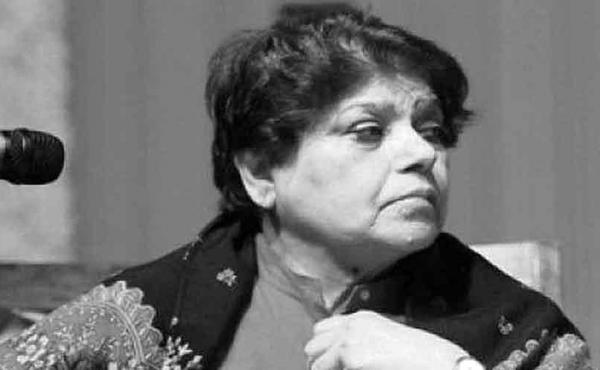K Kishwar Naheed wrote these lines on her 38th birthday. Birthdays and New Year nights are special moments. They are occasions for celebration, self-evaluation and making resolutions.
Kishwar Naheed, now 84 and suffering from age-related bodily deterioration, continues to speak out against the will of a patriarchal and authoritarian society. Her resilience and commitment to the power of words remain as strong as they were in her youth. She appears to have believed in Friedrich Nietzsche’s words: “All I need is a sheet of paper and something to write with; then I can turn the world upside down.

” Her poetry and prose have significantly contributed to changing the landscape of Urdu poetry and challenging societal perceptions of women. The power of the word is incomparable. She proudly declares in one of her poems, “I write poetry; I did not take my life.
” She seems to imply that it was poetry – the power of words – that protected her. She speaks out not just to gain recognition but also to achieve emancipation. In another poem, she vows, “I swear, if my eyes morph into a blister, I’ll shed tears and cry.
” Shedding tears and crying are forms of resistance. She has been determined to document the suffering experienced personally, by women around the world and by humanity at large. Modernists and progressives have had contrasting views on the power of words.
The modernists believed that when writers express hidden, repressed or tortured emotions. They gain relief and a sense of power. An authentic expression of repression provides both psychological relief and aesthetic repose.
The progressives, on the other hand, rejected the idea of the individual self, considering it illusory, dangerous and anti-humanist. They believed that writers should forgo their individuality and instead embrace the suffering of the oppressed. According to the progressives, when a writer gives voice to the sufferings of the collective self, their words become powerful tools for bringing attention to and recognising the sufferings of the oppressed.
This act breaks the silence and acknowledges their misery. Kishwar Naheed is overtly progressive, yet subtly modernist. She writes about her fleeting, sensual, romantic experiences and her social, economic and psychological struggles in a unique, individualistic style, following the aesthetic principles of modernism.
Her choice of words is distinct, cliché-free and drawn from ordinary life. Moreover, she avoids the jargon associated with Urdu progressive writers. A significant portion of her and poetry is inspired by personal experience.
For instance, these couplets are not only exemplary of the best composition but also a fine expression of her feminist identity. These couplets are characteristically modern and avoid classical or progressive diction. (Who did not say that he was a stranger and an alien? But my heart didn’t have trust anyone) (Such was the fervour in the marketplace of desire, that the heart made purchases without pausing for a careful evaluation) (Naheed looked somewhat pale today! Her scarf too was not of a bright colour) (Household chores never seem to end, Naheed.
Even if should I wish to step out in the evening) During the early days of her literary career, the Cold War and the clash between progressives and modernists dominated the literary scene. However, she did not align herself with this conflict. Instead, she blended seemingly antagonistic literary ideologies.
In the nascent years of her career, she appears to have created a balance between modern formalist aesthetics and the progressive ideas of resistance literature. Over time, her affiliation with modern, individual aesthetics became less pronounced and she began to broaden her concept of self, encompassing the experiences of marginalised women and common people. Her inclination toward the progressive view of literature became more evident.
The history of feminist literature shows that women writers often feel an existential urge to be progressive. However, her imagination still experienced nostalgia for pure modern aesthetics. Throughout her literary career spanning over more than six decades, Naheed has consistently believed in the inseparability of society and literature.
She has accepted this as a dogma: literature exists only to depict contemporary society with all its miseries, sufferings and contradictions. This belief explains the main themes of her writings in prose, translation and poetry. Much of her work is driven by the painful realisation that being a woman is often seen as a curse.
It’s important to understand the type of feminism she appears to embrace. She aligns herself with progressive Marxist feminism rather than radical feminism. She recognises that the challenges faced by women stem from historical patriarchal dominance, stereotypes and ideologies, rather than from nature or divine intention.
Throughout history, women have been perceived as inferior beings, treated like children, fools and subhumans. Naheed has not only boldly exposed the mistreatment of women in Pakistan, Asia, Africa and the West, but also worked to secure their liberation. As a feminist, she thinks globally but acts locally.
This is evident from her concise Urdu translation of Simone de Beauvoir’s magnum opus , under the title . She has also edited a volume containing Urdu translations of essays on women’s place in history, culture, art and their current plight. She seems to believe that poetry has the power to heal and emancipate.
We can differentiate between two kinds of feminist poetry. One involves a passive, gloomy and dejected portrayal of women’s misery and agonies. The second kind adopts a bold, satirical and stirring approach to depicting women’s condition.
Naheed has embraced the latter form of poetry. In (Sweeper), she writes: In another poem, (Last Decision), she sarcastically says “I wish, I could gulp all those who killed my spirit.” Resilience is the defining feature of her poetics.
The grass symbolises her resilience. In (Grass is like me), she says: There are various styles of resistance poetry: bold and direct, symbolic, oblique, satirical, ironic, and self-rebuking. Naheed’s poetry sometimes takes a bold direct approach; at other times it is satirical or self-rebuking.
Her poetry consistently features a self-rebuking style. In her prose writings, she has explained that the historical representation of women is often characterised as a malevolent force, a source of sin and evil. In a self-rebuking manner, she asserts that women are indeed condemned to “sinful, cursed lives.
” The expression of self-reproach is an indirect method of conveying sentiments. The implication is that women are regarded as sinful, not because they have committed sins, but because they are perceived as sinful. She courageously acknowledges that women have been the primary targets of pejorative language.
Consequently, she selected the title for her autobiography as (The Story of a Bad Woman). In the tradition of oriental mysticism, there is a group of Sufis known as , who engage in the practice of self-reproach. In mysticism, self-reproach is a powerful tool for self-negation.
However, for Naheed, self-rebuke serves the purpose of negating and subverting the influence of patriarchal ideologies and values. In reproaching the imposed identity, she effectively challenges the dominance of a male-centric, powerful societal structure. This ironic style of self-rebuke is exemplified in her most celebrated poem, (We, the Sinful Women).
In this poem, the conventional meaning of “sinful” is transformed into a representation of courage, audacity, defiance and valour. The poem challenges the symbols of patriarchal authority in a bold and celebratory manner. (Translated by Rukhsana Ahmad) As mentioned above, in the early stages of her literary career, Naheed established a fine balance between literature as an expression of self and literature as a vehicle of social change.
In a few of her more recent publications, we observe a certain tension between these two strands of literary theory. Over the years, she seems to have realised that creating poetic beauty and scripting agonies of daily life are at odds. The everyday existence is replete with distress and suffering, rendering it devoid of poetic quality.
The aesthetic appeal of art and the repulsiveness of reality are incompatible. We are compelled to watch pain, torture and suffering that leave no room for the beauty of art. The genesis of this tension may be traced to the concept of the writer’s role.
Initially, she chronicled her personal experiences, subsequently delving into the experiences of women more broadly and ultimately exploring the experiences of humanity beyond the boundaries of gender, religious faith and national identity. In later years, her demeanour matured into that of a mother. Like a mother, she feels the pain of every living being and uses her poetic words to console them.
Her recent works focus on the experiences of marginalised communities, including the Hazara community, the people of Lyari and those from Baluchistan. Her book (Beyond the Sweat Poetic Eloquence) delineates this tension. All tensions, including this, can be transformed into a source of creativity.
Nay Nnqqad kay Naam Khatot Urdu Adab ki Tashkeel-e-Jadeed.



















